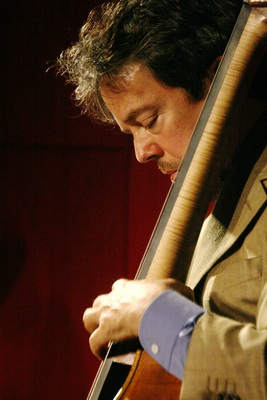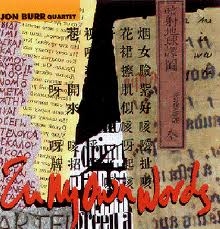Blear – Jon Burr
Though this song's tempo is quite fast, the sparse melodic and harmonic rhythms make it seem much slower. The bass line is largely more active than the melody; dynamics and phrasing are very important to make this song work.
- Recording: Jon Burr - In My Own Words
- Recorded on: April 7-8, 1993
- Label: Cymekob (CYK 804)
- Concert Key: C minor
- Vocal Range: , to
- Style: Swing (uptempo)
- Tenor Sax - Rich Perry
- Piano - Bill Charlap
- Bass - Jon Burr
- Drums - Terry Clarke
Video
- Description
- Historical Notes
- Solos
- Piano Corner
- Bass Corner
- Drum Corner
- Guitar Corner
- Inside & Beyond
- Minus You
This song presents an unusual challenge: creating a quiet, at times static modal texture at a very fast tempo. It's built around a bass line, which in most of the head is more active than the melody. The main, four-measure rhythmic figure in this bass line starts with three dotted quarter notes, going across the barline to a fourth note starting on the "and" of beat 1 of the second measure and held to the end of the phrase. The phrasing of this figure is indicated in our C lead sheet as "legato throughout (not syncopated)"—the offbeats in the figure are not accented, so that it floats over the time like slightly laid-back half-note triplets.
In the 9th through 11th measures of the head, the bass line does switch to half-note triplets; here, the line has a more stepwise motion than the previous phrase which begins with an ascending fourth. In the first 12 measures of the head, the melody consists of single long tones held for four measures each, the second and third of these anticipated by two beats. Starting in the 13th measure, the melody and harmony join the dotted-quarter-note bass figure; another melodic long tone and a development of the triplet bass line return for the last four measures of this 24-measure A section.
The 16-measure B section begins with a contrasting bass figure, a pedal point on beats 1, 2, and 4; the melody comes in after four measures with a faster arpeggiated line, followed by another development of the bass's half note triplet figure. The head is repeated twice. Dynamic contrast is very important to make the head work; the climactic points are the 13th through 20th measures of A and the 9th measure of B, coming back down between these points and after them.
Each chord is held for four or eight measures; there are some passing chords in the head, and the solo form is a simplified version. The first chord, Csus(9), is a sus chord with a 9th but no 7th (C-F-G-D). Several of the chords can be interpreted as inversions or slash chords, such as E♭maj7(♯5) in the 9th through 12th measures of the B section which is essentially G/E♭. The first chord of the B section is F/A, though Am7 is essentially played in the solos; the melody here implies another interpretation as F triad over A triad.
An eight-measure interlude precedes each solo, with the bass figure from the beginning of the head played twice.
Second parts are available for a quintet arrangement. Though the recording features a quartet, the piano plays two-part harmony with the melody in most places; we have made these harmonies into a second part. The C treble clef lead sheet is a two-staff lead sheet which shows the bass line; rhythm section players must read this lead sheet, as the C bass clef lead sheet has only one staff with the melody. All the bass rhythms are written below the staff on the transposed lead sheets and second parts.
In the 9th through 11th measures of the head, the bass line does switch to half-note triplets; here, the line has a more stepwise motion than the previous phrase which begins with an ascending fourth. In the first 12 measures of the head, the melody consists of single long tones held for four measures each, the second and third of these anticipated by two beats. Starting in the 13th measure, the melody and harmony join the dotted-quarter-note bass figure; another melodic long tone and a development of the triplet bass line return for the last four measures of this 24-measure A section.
The 16-measure B section begins with a contrasting bass figure, a pedal point on beats 1, 2, and 4; the melody comes in after four measures with a faster arpeggiated line, followed by another development of the bass's half note triplet figure. The head is repeated twice. Dynamic contrast is very important to make the head work; the climactic points are the 13th through 20th measures of A and the 9th measure of B, coming back down between these points and after them.
Each chord is held for four or eight measures; there are some passing chords in the head, and the solo form is a simplified version. The first chord, Csus(9), is a sus chord with a 9th but no 7th (C-F-G-D). Several of the chords can be interpreted as inversions or slash chords, such as E♭maj7(♯5) in the 9th through 12th measures of the B section which is essentially G/E♭. The first chord of the B section is F/A, though Am7 is essentially played in the solos; the melody here implies another interpretation as F triad over A triad.
An eight-measure interlude precedes each solo, with the bass figure from the beginning of the head played twice.
Second parts are available for a quintet arrangement. Though the recording features a quartet, the piano plays two-part harmony with the melody in most places; we have made these harmonies into a second part. The C treble clef lead sheet is a two-staff lead sheet which shows the bass line; rhythm section players must read this lead sheet, as the C bass clef lead sheet has only one staff with the melody. All the bass rhythms are written below the staff on the transposed lead sheets and second parts.
"In My Own Words" was Jon's debut album as a leader. For another from this album, check out Rainbow Over Harlem and Smokin' O.P.'s. This was Jon's first recording with drummer Terry Clarke; coincidentally, in the previous year Jon made his only recording with Clark Terry, on a live album led by Dorothy Donegan aboard the S.S. Norway. Later in the '90s, Burr and Clarke recorded together with vocalists Mary Foster Conklin and Catherine Dupuis. "In My Own Words" is the only recording, as of now, that Burr has done with either Rich Perry or Bill Charlap.
Jon Burr: "I remember looking out the window when writing this—it was a cold, rainy day and the windows were steamed up, and it was foggy outside. The bare trees outside looked fuzzy and indistinct, as opposed to their usual sharp winter nakedness. The word “Blear” came to mind, and went onto the page."
Jon Burr: "I remember looking out the window when writing this—it was a cold, rainy day and the windows were steamed up, and it was foggy outside. The bare trees outside looked fuzzy and indistinct, as opposed to their usual sharp winter nakedness. The word “Blear” came to mind, and went onto the page."
Related Songs
Email Send Blear to a friend
Send this page to a friend via email. Add your name or email in the first field. In the second, add one or more email addresses, separated by a comma.

Jon Burr
born on May 22, 1953
Renowned bassist Jon Burr is a mainstay in the New York scene. At the age of 16 Charles Mingus asked him to sit in on bass at the Village Vanguard and Jon has steadily risen in the jazz world since then. He has worked alongside many of the jazz giants while cultivating his own unique sound. His early discography shows us that he hit the ground running upon arrival in the Big Apple, and includes recordings with Buddy Rich and Chet Baker. Read more...
There was a problem.
...

